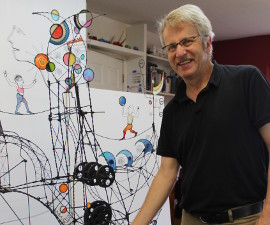T.S. Giilck

It’s a unique form of mechanical sculpture most closely akin to a style of art the British call “automata”, he explained. It’s a style most people have likely never seen or imagined, and is best appreciated in person. Next month, he will be starting concurrent exhibitions in Collingwood and Toronto galleries.
Paterson has been pursuing this art for several years now, and is starting to build a fan base internationally and domestically. It’s a big switch for an artist who originally started with excellent, but more conventional, paintings. Paterson said, though, he now believes he’s been working up to this style from his earliest childhood.
He related how, spending his early years in Saskatchewan, he was fascinated with a giant piece of abandoned farm equipment that his grandparents had on their property. He said he spent countless hours playing on the machinery, and he can now see a resemblance between the esoteric pieces with moving parts he’s now creating and that rusting hulk.
“I think these pieces are what I’ve been meant to do all my life,” he said with a wide smile. “When I look back at things, I’ve always been trying to capture motion in one way or another.
“I call them prayer machines, because they have an ambiguous machine-like look to them. They have moving components. What’s the first thing you’re told as a student on a field trip to an art gallery? Don’t touch anything. But they are meant to be touched, they need to be touched.”
The name comes from an epiphany Paterson had a year or two after giving up painting several years ago. He was tired of the medium, he said, and exhausted with art in general at the time. “I was tired of art, and wanted a break for one year. It turned out to be three years.”
He and his wife Lynn were living in Germany at the time inspiration struck, Paterson said, working in jobs that had nothing to do with art. While he had been tired of art, obviously the spark was still there. It simply needed another forum to manifest itself.
“While I was there, it was just such a change, and a culture shock. I had a crisis of faith, too, and I couldn’t find the words to talk to God. I just started playing with wire and making these little sculpture things. When I could pray again, I started calling them prayer machines, and the artist in me took over. People where I was working started wanting them, and when we came back to Canada in 2011, I resumed my art career and started developing them as art pieces.”
He showed his work for the first time in 2013. There was enough interest in the pieces to continue, and he signed up for a large show in Toronto. Despite much interest, Paterson said he only sold two pieces. However he met a dealer who eventually invited him to the world’s largest art show in Miami later that year. Things evolved rapidly from there.
“On the one hand we love mechanical things, because they’re an extension of ourselves, but we’ve also lost touch with things that seem more real.”
He’s now travelling to large shows across the continent with the striking, somewhat abstract pieces he’s producing. It’s taken some time, but there is now enough of a market to make his work a success. “It’s getting there,” Paterson said. “We sell a lot, but it also costs a lot.”
Prices range from around the $250 mark, up to as much as $20,000.
His show at the Butter Gallery in Collingwood is his first local exhibition. It opens July 1, and runs until the 15th. Simultaneously, an exhibition opens at the Petroff Galley in Toronto.
It’s called the “One-man, One-wall, Two galleries” series.
Photo:
James Paterson with one of his prayer machines. The Meaford-area artist is preparing for simultaneous shows in Toronto and Collingwood beginning July 1. T. Giilck photo.












